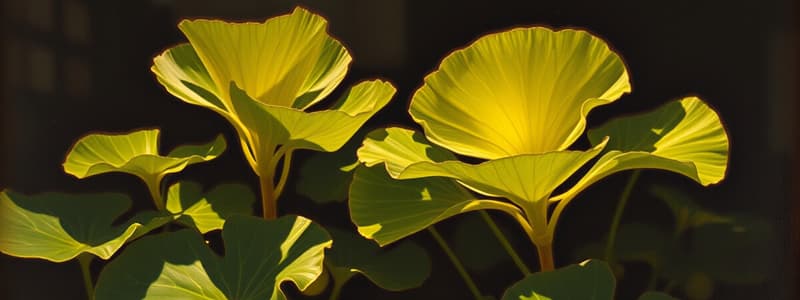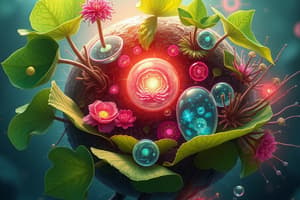Podcast
Questions and Answers
What is the chemical relationship between the light-dependent and light-independent (Calvin cycle) reactions of photosynthesis?
What is the chemical relationship between the light-dependent and light-independent (Calvin cycle) reactions of photosynthesis?
The light-dependent reactions use light energy to produce ATP and NADPH and split water, while the light-independent reactions use ATP and NADPH to fix CO2 into glucose during the Calvin cycle.
Will photosynthesis continue indefinitely in the light with no CO2? Why or why not?
Will photosynthesis continue indefinitely in the light with no CO2? Why or why not?
No, photosynthesis cannot continue indefinitely without CO2 because CO2 is a raw material that is necessary for converting to glucose.
Will mitochondria be present in the cells of an onion bulb, which do not contain chloroplasts?
Will mitochondria be present in the cells of an onion bulb, which do not contain chloroplasts?
True (A)
How do plant cells that do not contain chloroplasts survive?
How do plant cells that do not contain chloroplasts survive?
Signup and view all the answers
What are the six common types of proteins embedded within the membrane?
What are the six common types of proteins embedded within the membrane?
Signup and view all the answers
What is the Endosymbiosis Theory?
What is the Endosymbiosis Theory?
Signup and view all the answers
How do C3, C4, and CAM plants survive under dry conditions?
How do C3, C4, and CAM plants survive under dry conditions?
Signup and view all the answers
Where do the light-dependent and light-independent reactions of photosynthesis take place?
Where do the light-dependent and light-independent reactions of photosynthesis take place?
Signup and view all the answers
Study Notes
Photosynthesis Overview
- Light-dependent reactions use light energy to split water, producing ATP and NADPH.
- Light-independent reactions (Calvin cycle) utilize ATP and NADPH to fix CO2 into glucose.
- Light-dependent reactions occur in thylakoid membranes; light-independent reactions take place in the stroma.
CO2 Dependency in Photosynthesis
- Photosynthesis requires CO2; its absence halts the production of glucose.
- Initial reactions can continue briefly, but lack of CO2 eventually stops NADP and ADP production.
Mitochondria in Non-Chloroplast Plant Cells
- Onion bulb cells lack chloroplasts but contain mitochondria.
- Plant cells without chloroplasts obtain sugars from other plant parts containing chlorophyll that perform photosynthesis.
Types of Membrane Proteins
- Active Transporters: Require ATP to move molecules against concentration gradient (e.g., serotonin transporter).
- Passive Transporters: Facilitate movement of molecules to lower concentration areas (e.g., glucose transporter).
- Receptors: Trigger cellular changes in response to external signals (e.g., insulin receptors).
- Cell Adhesion Molecules: Aid in the adhesion of cells (e.g., cadherins).
- Communication Receptors: Form junctions between cells for cytoplasmic connection (e.g., connexins in gap junctions).
- Recognition Receptors: Distinguish self from non-self molecules (e.g., histocompatibility molecules).
Endosymbiosis Theory
- Suggests eukaryotic organelles arose from symbiotic relationships with prokaryotes.
- Aerobic bacteria evolved into mitochondria; cyanobacteria evolved into chloroplasts.
- Evidence includes double membranes around mitochondria and chloroplasts, indicating engulfment.
Carbon Fixation Processes in Plants
- C3 plants are inefficient in dry conditions; open stomata during the day, risking water loss and photorespiration due to high O2 levels.
- C4 plants utilize PEP to preferentially bind CO2 and minimize photorespiration; they convert OAA into malate.
- CAM plants also utilize PEP and keep stomata closed during the day, fixing CO2 during night to conserve water.
Light-dependent and Light-independent Reactions
- Light-dependent reactions harness sunlight to generate energy carriers; occur in thylakoids.
- Light-independent reactions use these energy carriers to convert CO2 into glucose; take place in the stroma of chloroplasts.
Studying That Suits You
Use AI to generate personalized quizzes and flashcards to suit your learning preferences.
Description
This quiz focuses on the chemical relationship between the light-dependent and light-independent reactions of photosynthesis. It also covers where these processes occur within the chloroplast, providing a comprehensive review for biology students.




